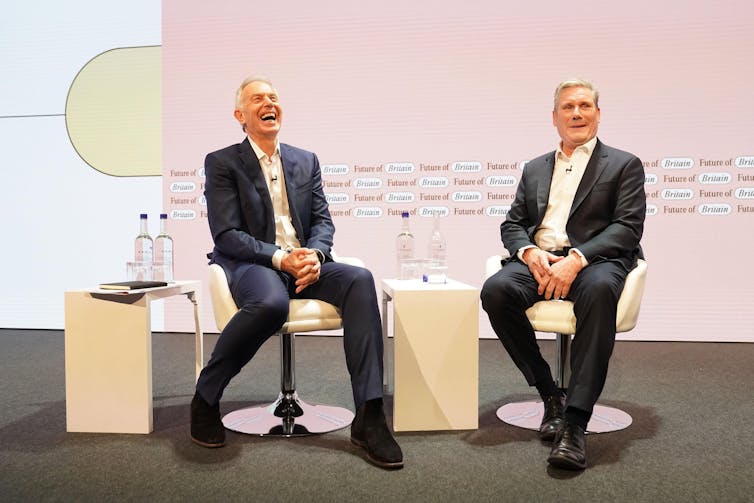Tony Blair left Downing Street nearly 17 years ago, but in terms of his impact on the Labour party, it’s almost like he never left.
After Gordon Brown led Labour into the 2010 general election, and lost, the party entered what has turned out to be a lengthy spell in opposition. Labour changed a lot after that point, including some ways nobody could have predicted.
There was a common theme, though, which I describe in my book, Getting Over New Labour. Actions taken after 2010 were often motivated by a desire to be (and were presented as) in marked contrast to New Labour.
What is striking is that, regardless of people’s particular views on New Labour, we are still talking about it. When Blair speaks, he gets headlines. And the contemporary Labour party is still somewhat animated by a reaction to the politics of the 1990s.
The New Labour legacy
When David and Ed Miliband contested the 2010 Labour leadership election, along with Diane Abbott, Ed Balls and Andy Burnham, they did so in the shadow of New Labour. The “rival” political identities of Blair and Brown loomed large. Ed Miliband had worked closely with Brown for many years, David Miliband more with Blair. When Ed Miliband triumphed, he did so, he later said, as “the ‘moving on from New Labour’ candidate”.
The list of New Labour achievements, certainly from a Labour party member’s perspective, is long. So too is the list of mistakes. Blair had left office in 2007 an unpopular figure, defined in large part by his continued belief that it was right for the UK to join the US in invading Iraq in 2003. The New Labour project itself had ended with the 2010 election, and the aftermath of the global financial crisis, which was followed by a Conservative-led government’s austerity programme.

Big questions about how New Labour had managed the UK economy, and specifically about continued high levels of economic inequality after the Conservative governments of the 1980s, took centre-stage within Labour. Miliband’s leadership, and Corbyn’s leadership after 2015, can be located in what the sociologist Mike Savage has called the “inequality paradigm” – a different set of propositions for understanding the world after the global financial crisis; ones that challenged New Labour’s acquiescence within an unfair economic model.
A different kind of party
While New Labour was electorally successful, some felt the project to have become too distant from both the party and the people – too technocratic and too “top-down”.
David and Ed Miliband both believed in the party resembling a “movement” once again, and this was important for much of Jeremy Corbyn’s leadership, too. It was another way of moving on from New Labour. Embracing a different kind of politics was also key. Labour wanted to become less obsessed with focus groups and unafraid of challenging conventional wisdom.
Just how successful was this? The post 2010 story is a paradoxical one. It was electorally unsuccessful, though at times defied political pessimism. There were new ideas coming from the Labour party, often based upon a convincing account of the problems the UK faced.
There were some big failures, too. Corbynism ultimately could not manage the politics of Brexit. On what became the defining political issue of the 2017-2019 period, Corbyn’s leadership seemed to lack both certainty and principle. And on organisational culture, the Corbyn project failed, most seriously when it came to tackling antisemitism within Labour.
New Labour today
New Labour factionalism has lessened over the past few years. New generations of Labour politicians and activists are beginning to treat the New Labour project like any other part of the party’s past.
And there is much for policymakers to learn from studying the recent past – just look at recent evidence about the difference made by New Labour’s flagship Sure Start programme, for example. It is less productive, I think, to continue debating New Labour’s personalities.

Since Keir Starmer has become leader, there has been something of a counter-reaction to how New Labour was interpreted and debated during the Corbyn and Miliband years. Starmer was initially elected leader with a narrative similar to that of his predecessors, including the theme of moving on from New Labour. He has since, however, sought a much stronger association with the New Labour record. That has included interacting with Blair and his high-profile, influential thinktank the Tony Blair Institute for Global Change.
Starmer seems much keener than his predecessors to be associated with New Labour – particularly, unsurprisingly, its record of winning three general elections. That doesn’t, however, make the contemporary party a “continuity New Labour” project. On economic policy, for example, shadow chancellor Rachel Reeves has spoken extensively about how the politics of the 1990s and early 2000s – and the economics of New Labour – had significant weaknesses. Globalisation was a leitmotif for Blair’s take on the modern world. According to Reeves: “globalisation, as we once knew it, is dead”.
After 2010, the Labour Party couldn’t stop talking about New Labour. Starmer’s leadership marks a change on that front: less talking about “moving on”, but still actually moving on.
Yet, like everyone, politicians are still trying to understand an uncertain world. They will continue looking back at the near-past to explore the origins of certain problems, and to justify how they wish to change things. We haven’t, then, heard the last of New Labour.

